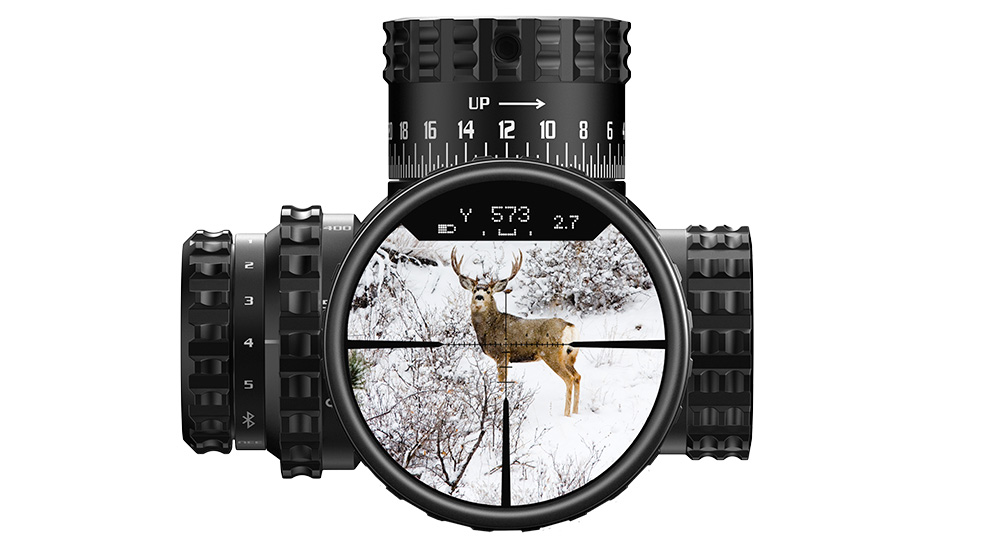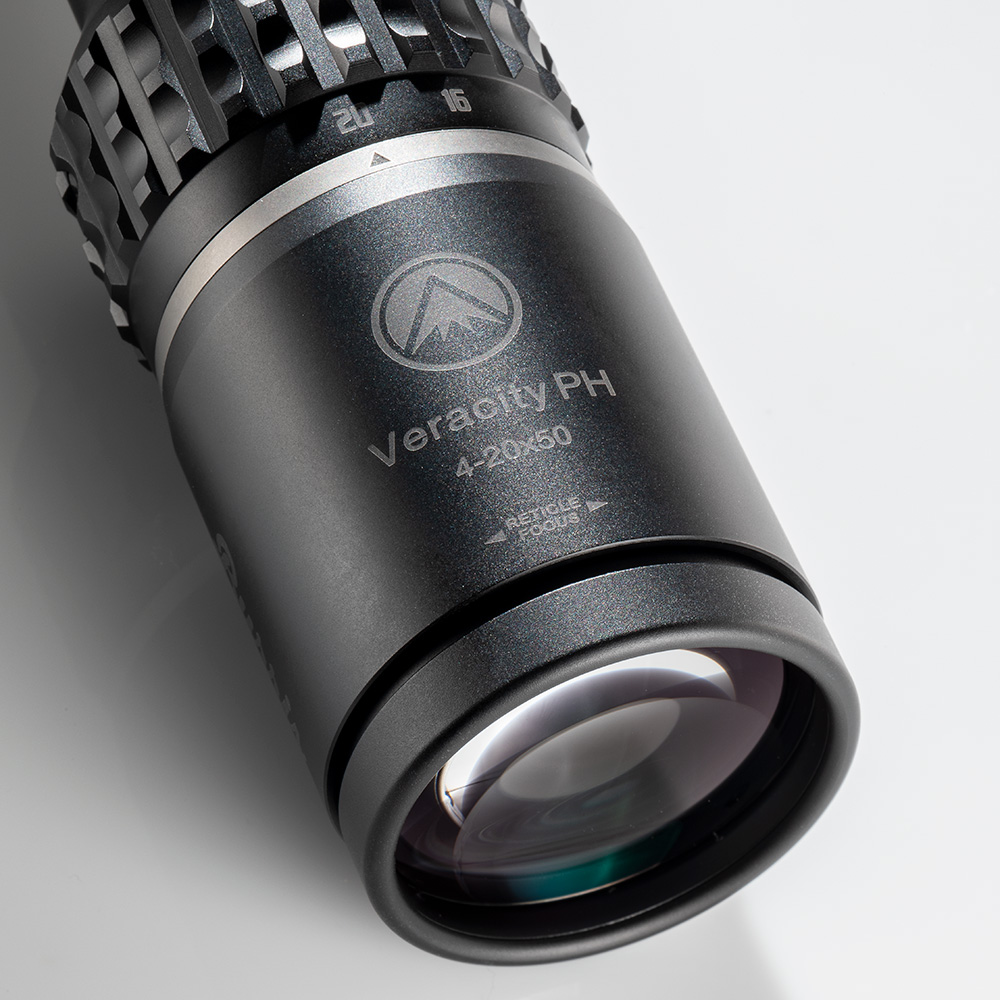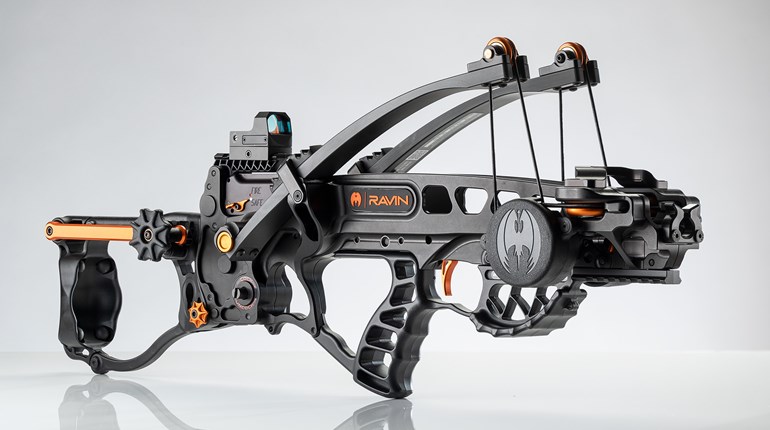
Wouldn’t it be great to dial your scope’s elevation to correct for the range-to-target while looking through it, keeping everything in view, without counting clicks? Just like everything else in life, there’s an app for that. No, really.
Burris has introduced a Bluetooth-enabled scope called the Veracity PH 4-20X50mm that syncs with their BurrisConnect app. The app pushes the ballistic data of your rifle/cartridge combination to the scope. As you dial the scope’s elevation knob for the range to the target, in real-time an internal heads-up display (HUD) shows the distance, or the MOA adjustment, the scope is being dialed for. Instead of counting the clicks, simply turn the knob while watching the display. The HUD also provides other critical ballistic information such as whether your rifle and scope are level, and it provides a ballistically matched windage hold for the wind speed you predetermine in the app. All ballistic or environmental values can easily be changed in the app at any time to adjust for field conditions.

While it may not be the targeting computer in an X-Wing, this system does eliminate the need to carry a ballistic chart or calculator. Simply range the target, then while looking through the scope with the target in view, dial the elevation knob until the desired range or MOA correction is showing on the HUD. This can be a critical time saver, one that could make the difference between making the shot or watching your deer or elk slip into cover.
The headline feature of the Veracity PH is Burris’ new Programmable Elevation Knob, or “PĒK.” The knob, which is “clickless” by the way, has a digital position sensor. It keeps track of the rotation, which is calibrated to adjust the scope to 1/10th MOA accuracy. The knob also has ¼ MOA markings for redundancy. The digital sensor works in conjunction with the onboard electronics, the HUD and the BurrisConnect app. It seemed a bit hinky to me at first, but after I stopped channeling my inner Boomer, it all made sense. Elevation is still being mechanically adjusted like any other scope, albeit in finer increments. The position sensor, onboard electronics and the app work in conjunction to track and tell you how much the scope is being adjusted, and in the case of the ballistic data uploaded to the scope, what range the elevation is being adjusted for.
The Veracity PH enters the game with an old school 30mm tube. While this limits the amount of elevation and windage adjustment available, it gives the shooter a wide selection of scope mounts and rings to choose from. The elevation knob is exposed without a rotation lock, but it does have a zero stop, so immediately reorienting the scope isn’t an issue, and the knob is tight enough that it’s unlikely to accidentally bump out of position. The windage knob is covered with a threaded cap. The other features will be familiar to most shooters such as a fast-focus eyepiece, a low-profile power selector ring, side parallax focus and a rotating on/brightness control dial for the heads-up display. All control surfaces have an aggressive, machined texture that provides a secure grip. Overall, the scope has good ergonomics.
The 4-20 magnification range gives the shooter a useful low-magnification option and field of view while still having enough zoom-in capability for accurate aiming at extended distances. The 50mm objective combined with multi-coated lenses is a good choice for good low-light performance.
A Burris Wind MOA FFP reticle complements the “PĒK” technology. The HUD will show the correct windage hold value for the range dialed into the scope. The reticle has MOA windage marks, making it easy to make the proper correction before the shot. It also has some elevation holdovers with the specific values for each mapped out in the app once your cartridge’s data is entered. This is a first focal plane reticle, meaning the reticle grows or shrinks as you zoom in and out, thus staying the same size in relation to the target.
This scope has a lot of features, which is all great and fine, but only if they work as advertised. I also wanted to see if setup was going to be easy or like suffering through a physics exam. For testing I paired the scope with a Ruger Precision Rifle in 6mm Creedmoor. Mounting was straight-forward with plenty of room for the scope rings. This scope required a bit more testing because of the electro-wizardry. Normally I would shoot it, see if it tracked accurately, drown it, freeze it, drop it and call it a day. But testing the HUD required checking if it matched up with other ballistic data sources, brightness levels, etc.
Testing was done with match ammo from Hornady and Sierra. Both are extremely accurate loads, removing the ammunition variable from the equation. Zeroing the rifle was quick with only a few shots necessary because the scope’s adjustments tracked exactly as they should. The image quality is quite good with no obvious distortions or issues while looking at the grid lines of the target.

Setting up the Veracity to use the HUD with my ballistic data was, in fact, pleasantly easy. Just zero the scope as you normally would. Loosen the zero-stop and adjustment knob screws, set the dial to “0” and tighten the screws. With your ballistic data entered into the app, connect to the scope via Bluetooth, upload the ballistic data and “zero” the position sensor via the app. That’s it. You’re ready to range and shoot. I cross-referenced the BurrisConnect ballistic data with another ballistic app and a Kestrel and it matched within .5 MOA at 600 yards.
The information displayed on the HUD is irrelevant if the scope’s elevation adjustment isn’t tracking accurately. To see if the mechanical adjustment matched the info on the display, I shot a box test, running both the elevation and windage knobs almost their full range of adjustment. The elevation adjustment tracked perfectly within the variance of the size of the group. The windage was perfect in practicality, showing only a small, 1 MOA variance at the very end of adjustment, which is irrelevant unless you are shooting in hurricane-speed winds and need to dial over 12 MOA. No one does that. I also shot the box test after heating the scope with a heat gun, leaving the scope in a cooler full of ice packs, and after leaning the rifle and scope setup against my clapped-out compressor for about 30 minutes to provide some shake, rattle and roll. The scope remained zeroed each time and passed the tests with no issues.
The Veracity also survived and worked as it should after some unscientific, albeit painful to watch, drop tests, and it remained waterproof after staying submerged in shallow water for 30 minutes.
This is an interesting scope that integrates technology that is actually useful. It saves having to carry an extra piece of gear like a Kestrel and can save time getting everything dialed in for a critical shot. The ergonomics are familiar and work well. While the 30mm tube limits the amount of elevation adjustment, it does mean almost any type of scope mount is available. That said, if you plan on shooting at extended distances you might need to get a 20 MOA forward-sloped base to increase some of the internal elevation adjustment you need. The only two minor issues I have with the Veracity PH are it would be nice to see a locking elevation knob that is a bit easier to turn, and some sort of little nub or throw lever on the power selector ring. But nothing is free and obviously that would raise the cost.
Overall, this is a well thought out, innovative scope that will perform well and add a fun and convenient factor when dialing your elevation adjustment to shoot at varying distances. This would be a great choice for a hunting rifle where shots at greater than point-blank distances are anticipated, and obviously would make a fantastic varmint or predator hunting scope where targets don’t wait around long for the hunter to prepare for the shot.
Technical Specifications
• Type: variable-powered riflescope
• Magnification: 4X-20X
• Objective Lens Diameter: 50mm
• Eye Relief: 3.5"-4.25"
• Exit Pupil: 12-2.5mm
• Field of View @ 100 Yards: 26 ft. (4X), 5.5 ft. (20X)
• Reticle: Wind MOA FFP
• Adjustments: ¼ MOA
• Coatings: index-matched Hi-Lume multicoating
• Dimensions: 30mm main tube; length 15"; weight 27.2 ozs.
• Construction: 1-piece main tube; high-performance glass; matte finish; nitrogen filled; waterproof
• Battery: CR 2450 (2)
• Additional Features: PĒK System, pairs w/BurrisConnect app via Bluetooth; illuminated HUD; zero-turn stop adjustment knobs
• MSRP: $1,199; burrisoptics.com





































